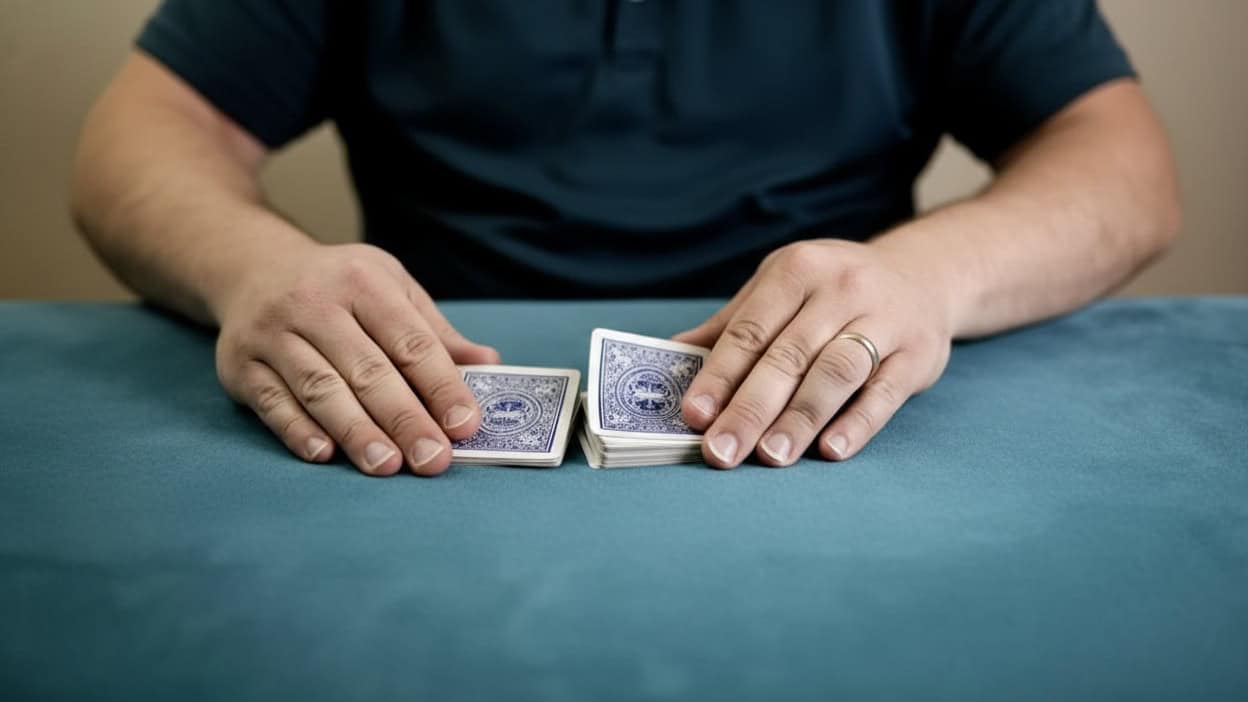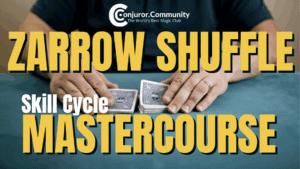Other blogs in this series:
- Why “Natural” Is the Last Thing You Should Try to Look →
- The Real Secret to the Zarrow Shuffle →
- From Frustration to Flow →
It’s Easier Than You Think—Once You Know Where to Start
Last time, we talked about uniformity—how what magicians call “natural” is really a kind of consistent sameness we build on purpose. This week, let’s put that to work on the move that has driven card workers crazy for decades: the Zarrow Shuffle.
When I first saw a Zarrow, I was fifteen, outside Al’s Magic Shop. A local magician—who’d taken a few lessons from Darwin Ortiz—riffle-shuffled on the table and I saw nothing. Not a twitch. It was perfectly invisible. I chased that for years. Books, tapes, late nights. Still never looked like that first one.
My teacher Pete Galinskas—an underground card man who read Erdnase with me in college—taught me something I didn’t understand at the time: if you want the false shuffle to pass, you first have to build the real shuffle so well that it defines reality for the audience. Only later did I see what that means in practice.
Recently, we asked Steve Reynolds—the most exacting Zarrow teacher I know—to teach a live course for our members. In Session 1, we rebuilt the fair table riffle from the ground up. In Session 2, Steve made a handful of precise corrections. In about 30 minutes, a room full of magicians at every level—many who had never truly table-riffled—started to look and sound like they’d been doing it for years. That change wasn’t luck. It was method.
Why the Zarrow Starts with the Fair Shuffle
The Zarrow only works when the false action and the fair action are indistinguishable to the audience—visually and audibly. You can’t rely on one or the other. You have to match both.
So before Steve touched the false shuffle, he rebuilt the real one. Three adjustments did most of the work:
- Forearms on the table
Stabilizes the action so the packets meet the same way every time. - Thumbs and second fingers aligned
Evens the release so you don’t get the small collisions that telegraph effort. - A shallow “V” between packets
Lets the cards meet without fighting each other.
When those three are in place, two things happen at once:
- The look of the shuffle loses the little snags and spasms that read as “work.”
- The sound becomes one even riffle rather than a series of clicks.
That’s uniformity. And once your fair riffle has it, the Zarrow has a real chance to disappear.
Practice That Actually Works in 10–20 Minutes
Most magicians get about twenty minutes of me time on a good night—the short window between everything else in life and the moment you run out of energy. You sit down with a deck and want to make it count.
Even when we know what to work on, we often lose that time in repetition.
When I was young, I really believed that if I just did a move over and over again, it would improve.
It took me years to understand that my approach didn’t work—in fact, it made things worse.
I never discovered what I was doing wrong, and at the same time, I built habits that made those unrecognized errors automatic.
Repetition just bakes in whatever habit you already have—good or bad.
Exploration opens up the practice process to real discovery.
That’s why this approach feels different from the first session onward: it replaces “drilling” with curiosity.
Steve’s method solves both problems.
You always know what to work on—and how to work on it.
You focus on the fair shuffle, and you use those minutes to explore, not repeat.
Think of it as the first homework from the class.
Spend your time rebuilding the fair riffle shuffle until it feels relaxed, balanced, and even.
That’s all.
If you do that for a few days, you’ll find that the Zarrow action—the false shuffle—begins to make sense on its own.
We won’t say it teaches itself (it doesn’t).
But when the fair action is correct, the Zarrow stops being a mystery and starts feeling achievable.
Try This Tonight — Give It Ten Minutes
If you want to test the idea for yourself, give it ten minutes tonight.
- Sit with a deck at a table.
- Rest your forearms on the surface.
- Align thumbs and second fingers on both packets.
- Form a shallow V so the packets meet without force.
- Riffle slowly until you hear one even, continuous shuffle.
- If you hear clicks or feel resistance, lighten pressure, re-align, and try again.
- Stop after five clean fair riffles.
That’s it—the first assignment from Steve’s class.
It’s simple, but it changes everything.
Because once the real shuffle looks and sounds identical every time, you’ve already done more than half the work.
The goal isn’t to fake one sense or the other—it’s to make what they see and what they hear perfectly agree.
And when those two things match, the shuffle finally feels real.
That’s where the Zarrow begins.
Master the Ultimate Invisible Shuffle
The Complete Zarrow System with Steve Reynolds, Aaron Fisher & Alex Slemmer
Turn the move every magician struggles with into one of your strongest weapons.
You’ll finally understand why the Zarrow works—and how to make it feel effortless, uniform, and completely invisible.
Here’s what you get inside:
- Three complete training modules that rebuild your shuffle from the ground up—fair first, false second, feedback always.
- Direct coaching from Steve Reynolds showing you how to fix tension, rhythm, and alignment in real time.
- Guided commentary from Aaron & Alex translating Steve’s underground expertise into clear, repeatable drills.
- Lifetime access to the full training vault—so your technique keeps improving long after the first run.
Learn the real system behind one of card magic’s most mythic moves—and make it your invisible shuffle.
Learn the Ultimate Invisible Shuffle
Explore Steve Reynolds’ complete Zarrow system — with guided commentary from Aaron Fisher and Alex Slemmer.
Regular Price $397
Today: $297
Next in this series: From Frustration to Flow →

